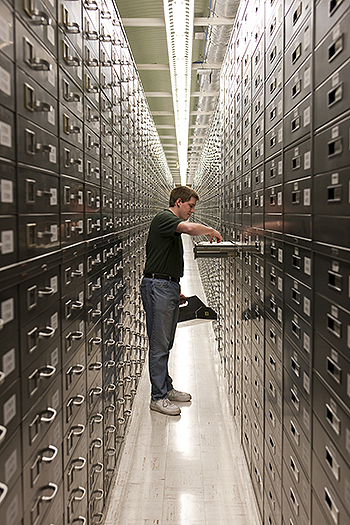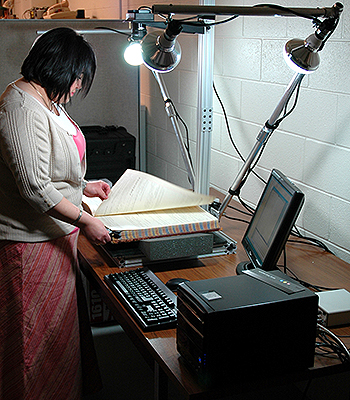FamilySearch Discontinuing Microfilm; Most Records Now Digitized
Contributed By FamilySearch.org

A man views a historic document using a microfilm viewer, technology the internet and digital cameras have made obsolete.
Article Highlights
- FamilySearch has digitally reproduced the bulk of its microfilm collection—over 1.5 million microfilms.
- Online access to digital images of records allows FamilySearch to serve more people, faster and more efficiently.
“Preserving historic records is only one-half of the equation. Making them easily accessible to family historians and researchers worldwide when they need them is the other crucial component.” —Diane Loosle, director of FamilySearch Patron Services Division
Related Links
FamilySearch announced June 26 that it plans to discontinue its 80-year-old microfilm distribution service. The transition is the result of significant progress made in FamilySearch’s microfilm digitization efforts and the obsolescence of microfilm technology.
The last day for ordering microfilm will be August 31, 2017. Online access to digital images of the world’s historic records allows FamilySearch to service more people around the globe, faster and more efficiently. See “Finding Digital Images of Records on FamilySearch.org” and “Frequently Asked Questions.”
A global leader in historic records preservation and access, FamilySearch and its predecessors began using microfilm in 1938, amassing billions of the world’s genealogical records in its collections from over 200 countries.
Why the shift from microfilm to digital?
Diane Loosle, director of the Patron Services Division, said, “Preserving historic records is only one-half of the equation. Making them easily accessible to family historians and researchers worldwide when they need them is the other crucial component.”
Loosle noted that FamilySearch will continue to preserve the master copies of its original microfilms in its Granite Mountain Records Vault as added backup to the digital copies online.
As the internet has become more accessible to people worldwide over the past two decades, FamilySearch made the decision to convert its preservation and access strategy to digital. No small task for an organization with 2.4 million rolls of microfilm in inventory and a distribution network of over 5,000 family history centers and affiliate libraries worldwide.
It began the transition to digital preservation years ago. It focused not only on converting its massive microfilm collection but also in replacing its microfilm cameras in the field. All microfilm cameras have been replaced with over 300 specialized digital cameras that significantly decrease the time required to make historic records images accessible online.

FamilySearch will continue to preserve the master copies of its original microfilms in its Granite Mountain Records Vault as added backup to the digital copies online.

Like this sister, missionaries help preserve historical records in archives around the world by capturing digital images of those records with equipment provided by FamilySearch.
FamilySearch has now digitally reproduced the bulk of its microfilm collection—over 1.5 billion images so far—including the most requested collections based on microfilm loan records worldwide. The remaining microfilms should be digitized by the end of 2020, and all new records from its ongoing global efforts are already using digital camera equipment.
Digital image collections can be accessed today in three places at FamilySearch.org. Using the Search feature, you can find them in Records (check out the “Browse all published collections” link), Books, and the Catalog. For additional help, see “Finding Digital Images of Records on FamilySearch.org.”
Transitioning from microfilm to digital creates a fun opportunity for FamilySearch’s family history center network. Centers will focus on simplified, one-on-one experiences for patrons and continue to provide access to relevant technology, popular premium subscription services, and restricted digital record collections not available to patrons from home.
Centers and affiliate libraries will coordinate with local leaders and administrators to manage their current microfilm collections on loan from FamilySearch and determine when to return films that are already published online. For more information, see “Digital Records Access Replacing Microfilm.”
